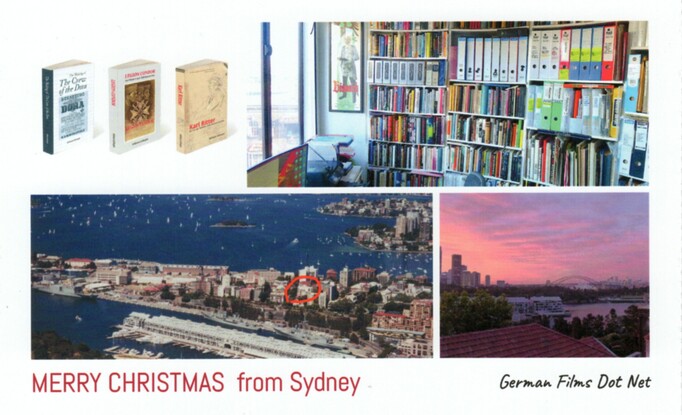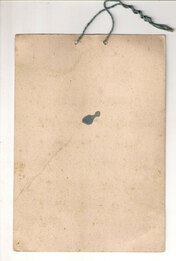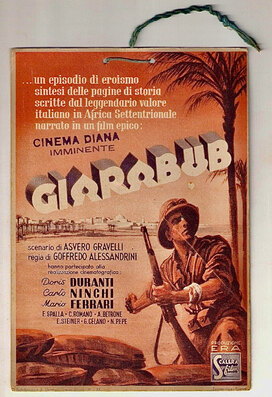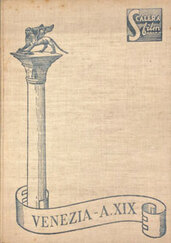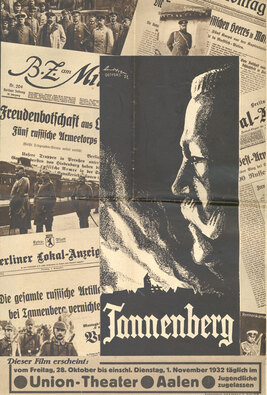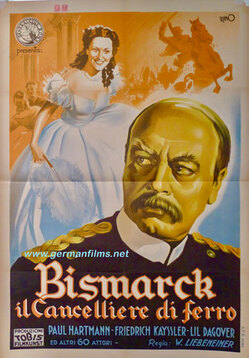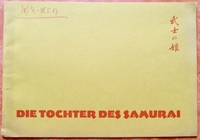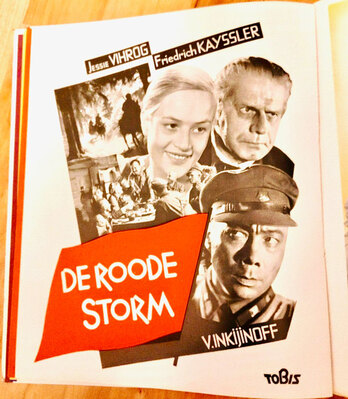- Home
- POSTER GALLERY
- ❗️BOOK & POSTER STORE❗️
- About the Posters
- The William Gillespie Collection
- Our Publishing House
- ❗️GFDN interviews author and collector William Gillespie ❗️
- Our most expensive & inexpensive finds!
- ❗️***NEW!*** Poster of the Month ❗️
- ❗️NEW ❗️Film Posters – Demands on an important means of film advertising. ❗️
- In our Book + Zeitschrift Library
- ❗️ ***NEW!*** Hitler Youth Quex – A Guide for the English–speaking Reader ***NEW!*** ❗️
- ❗️***NEW!*** Table of Contents of our new HJ QUEX book❗️
- ❗️Hitler Youth Quex Guide - early praise! ❗️
- Recent loans from the Collection
- Farewell Horst Claus. (1940–2024 †)
- "Der Deutsche Film" Zeitschrift
- ❗️ ***NEW!***German "Tendency" Films (Tendenzfilme) in the Third Reich ❗️
- KARL RITTER
- Karl Ritter original film posers in this Collection
- "Besatzung Dora" ( † 1943)
- "The Making of The Crew of the Dora"
- Karl Ritter at the 1938 Reichsfilmkammer Congress
- INDEX -"Karl Ritter" book, 2nd edition
- Karl Ritter's Legion Condor (1939, unfinished)
- Excerpt from our "Dora" book
- ∆∆∆∆∆ High praise for our DORA book! ∆∆∆∆∆
- TABLE OF CONTENTS – "Legion Condor"
- § § § § § Early Praise for our LEGION CONDOR book! § § § § §
- ❗️"Das Leben geht weiter" and Karl Ritter ❗️
- Zarah Leander Europe–wide !
- Japan Military Film and Karl Ritter
- Karl Ritter after 1945
- 1935 Film Congress
- Poster Exhibition in Berlin, March 1939
- Potsdam poster exhibition 12 April–25 August 2019
- Leni Riefenstahl's two "Olympia" Films (1938)
- "Ohm Krüger" (1941)
- Emil Jannings
- "Blutendes Deutschland" (1933)
- Hannes Stelzer ( † 1944)
- Klaus Detlef Sierck ( † 1944)
- Film stills
- Reich Film Censorship Offices
- ❗️Dateline: Ufa - April 11, 1945 ❗️
- ❗️***NEW!***The Fate of the German Film Industry in May 1945 ❗️
- Film censorship cards
- Film Archives
- Cinema advertising
- School filmstrips
- ❗️UPDATED❗️ Z F O / Ostland Film G-m-b-H
- Z F O / Herbert Jacobi estate
- ZFO / Ostland Film newspaper articles
- ❗️***NEW!*** Roter Nebel / Red Fog / Red Mist (1942/1943, ZFO) ❗️
- ZFO - Der Rückkehrer - The Returnee (1943/1944)
- The D F G production company
- D I F U
- ❗️ ***NEW!*** "Carl Peters" – Special Collection. ❗️
- "Alcazar" (1940, Genina)
- "Der 5. Juni" (1943, banned)
- ❗️ ***NEW!*** Herbert Selpin and his "Titanic" (1943) ❗️
- ❗️ ***NEW!*** Ein Robinson (1940, Fanck) ❗️
- "Fronttheater" (1942)
- Veit Harlan's Jud Süß and Fritz Hippler's Der Ewige Jude
- Harlan "Jud Süß" trial 1949
- Werner Krauss & JUD SÜß
- Anti-Semitic Film Posters in the Collection
- "Heimkehr" (1941)
- "Hitlerjunge Quex" (1933)
- ❗️***NEW!*** Hitlerjunge Quex in 111 Greater Berlin Cinemas ❗️
- Jürgen Ohlsen
- "S.A.Mann Brand" (1933)
- "In der roten Hölle" (Edgar Neville, 1939)
- "Helden in Spanien" (1938)
- The Spanish Civil War in Film
- Andrews Engelmann (1901 – 1992)
- Deutsche Wochenschau
- Uƒa Feldpost
- Uƒa Kulturfilm – Informationen
- " Die Tochter des Samurai" (1937, Fanck)
- Ufa 25th Anniversary
- Invitations to world premieres
- ❗️***NEW!*** Continental Films, Paris 1940–1944 ❗️
- Film Censorship in Occupied Paris 1942
- "Der Sieg des Glaubens" (1933)
- Wilhelm Althaus Estate
- Weimar Germany posters
- Ufa and the Ordensburgen
- The Gaufilmstelle in our Collection
- "Zwei Welten" (1940)
- "Capriccio" (1938) –Karl Ritter film album
- Unrealised NS Propaganda Films 1934–1945
- German Film Directors accused of "war crimes"
- Australian––themed NS feature films
- "Der Störenfried" / "The Troublemaker"
- What was new in 2014?
- What was new in 2015?
- What was new in 2016?
- What was new in 2017?
- What was new in 2018?
- What was new in 2019?
- What was new in 2020?
- What was new in 2021?
- What was new in 2022?
- What was new in 2023 ?
- What's new in 2024?
- ❗️***NEW!*** Hitler assassination attempt in Karl Ritter film cut❗️
- BESATZUNG DORA private photos
- Just discovered 1942 article on BESATZUNG DORA
- The Karl Ritter Tetralogy
- Google Analytics 2023
- Our first–ever acquisition!
- ❤️"Some of our favourite things....!"❤️
- ERRATUM for our " Hitler Youth Quex Guide"
- Trending
- Vale †
- Our Wants List / 2024 / Wunschliste
- Pop Quiz
- Unsere KARL RITTER Bücher in Deutschland liefbar!
- WHERE to buy our books right now?
- ✉️Contact
 “History is not about the facts. It is about the context and who is telling the story.” —Prof. Milton Fine.
“History is not about the facts. It is about the context and who is telling the story.” —Prof. Milton Fine.
"Who controls the past controls the future: who controls the present controls the past." –– George Orwell in his novel "1984."
"Whoever doubts the exclusive guilt of Germany for the Second World War destroys the foundation of post–war politics." –– Prof. Theodor Eschenberg, Rector, the University of Tübingen.
"If we have our own why in life, we shall get along with almost any how." – Friedrich Nietzsche
POSTER GALLERY --view
over 500 German film
original posters between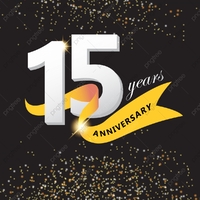
1927–1954 from
Germany and from
many Axis and Neutral countries
across Europe!
Note! Posters in the Poster Gallery are PERMANENT
acquisitions which are NOT FOR SALE!! ONLY the
posters listed in our POSTER STORE are for sale.
(They have a price and order button to use.)
What was new in 2021 ?
It did not take long for us to celebrate the start of hopefully a far healthier and more positive New Year. We have been offered privately and acquired this November 1942 film poster for the Splendid-Palace cinema in Riga, Latvia advertising the 1941 anti-modern art German propaganda film Venus vor Gericht (Venus on Trial), and the comedy Du und Ich (You and Me).
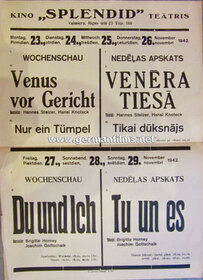
We have acquired this small (27 cm X 17 cm) interesting cardboard poster advertising piece for the famed Alessandrini Italian contemporary war film Giarabub.
We have three original posters for this 1942 film, which we consider amongst the top war films produced by Mussolini Italy. Our Poster Gallery also shows all of the Fotobustas for Giarabub which we have.
We also acquired the 1941–1942 Scalera Film studio preview book which includes Giarabub.
–––––––––––––––––––––––––––––––––––––––––––––––––––––––––––––––––––––
We announce here some private photos taken during the film–shoot of Karl Ritter's Luftwaffe film BESATZUNG DORA in the USSR in October 1942. They are in a Wehrmacht soldier's album, unlabelled, which we acquired in September 2018 in Berlin at auction. We had been misled as to their relevance because the auction listing attributed the few photographs in the album to Ritter's Stukas film of 1941. This auction took place 9 weeks after we discovered the long–lost film script for Karl Ritter's Legion Condor feature film. We became totally focused on researching, writing and publishing our new book on that film, and this photo album was put way back on the proverbial back–burner.
Anything to do with the banned Luftwaffe film "Dora" is exciting to us, although these photos, even had they been known to us at the time of purchase, would have missed our THE MAKING OF THE CREW OF THE DORA book's publishing deadline by more than two years.
Nonetheless, we are pleased to show some of them here for the first time:
Here is a candid photo of soldiers making the signage to be used in the FEINDFLUG ceremony scene, spreading the materials out along the train tracks:
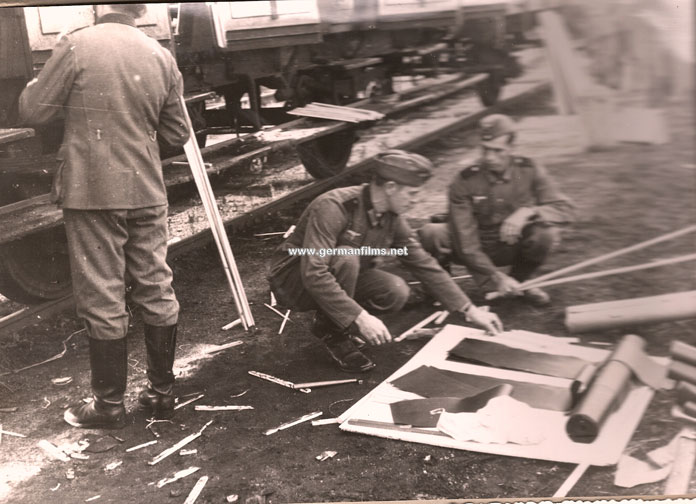
Here is the scene with film actors and actual Luftwaffe personnel and air crews before the filming (note the deckle edged snapshot photo taken from the album). The gren arrow points to a Ju88D aircraft in the background.

And here is the film scene as represented in the Ufa lobby card:
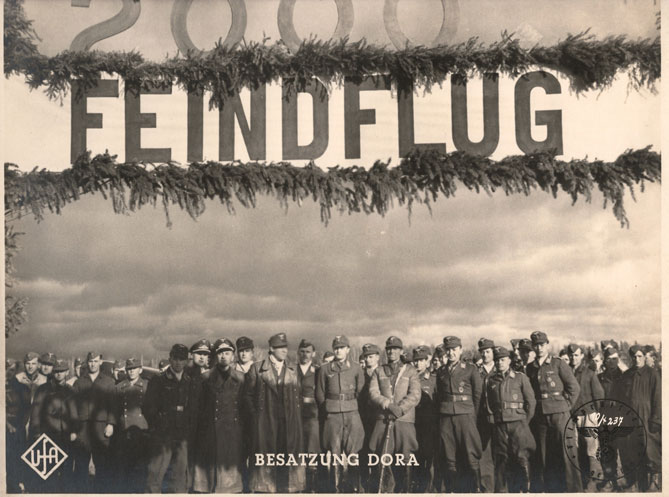
Here a candid shot of actor Joseph Dahmen 'conducting' in the Officer's Mess at the Gostkino Fliegerhorst in the Soviet Union, with soldiers looking on. The man at the extreme left of the photo in civilian clothes is Gottfried Ritter, Assistant Director to Karl Ritter and his youngest son.

The Ufa camera crew (Gottfried Ritter at left) in the muddy road of the Soviet village on the outskirts of the Gostkino air base:
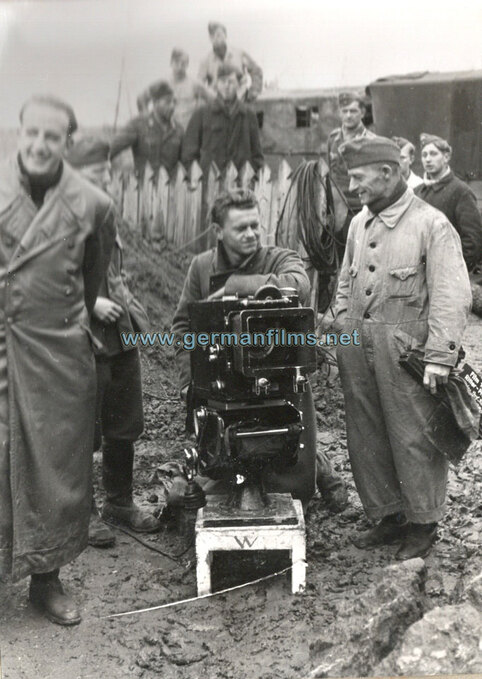
The final album photo is that of Karl Ritter, in Luftwaffe uniform, arriving at the filming location in his car. Note the Ufa 35mm motion picture camera in a weather-proof shroud. This is the first time this image has been published, along with the above photos.

–––––––––––––––––––––––––––––––––––––––––––––––––––––––
The KDDK; or Comradeship of German Artists was founded under the auspices of Dr. Joseph Goebbels, and on October 31, 1934, opened it's Berlin offices and lavish premises, with restaurant, bar,  meeting rooms, cinema and other facilities in a family villa of the assassinated Weimar Minister Walter Rathenau.
meeting rooms, cinema and other facilities in a family villa of the assassinated Weimar Minister Walter Rathenau.
The KDDK club had artists and their family members from across all art forms, from film to the visual arts. Film director Karl Ritter and his wife and their oldest son, Heinz, were members.
We have obtained the very rare 1940 membership directory to the KDDK. Below you can see the names of Karl, Erika and Heinz Ritter as members, alongside the date of their acceptance into the Association. Note Leni Riefenstahl's name, as well as those of other film stars and prominent artists.
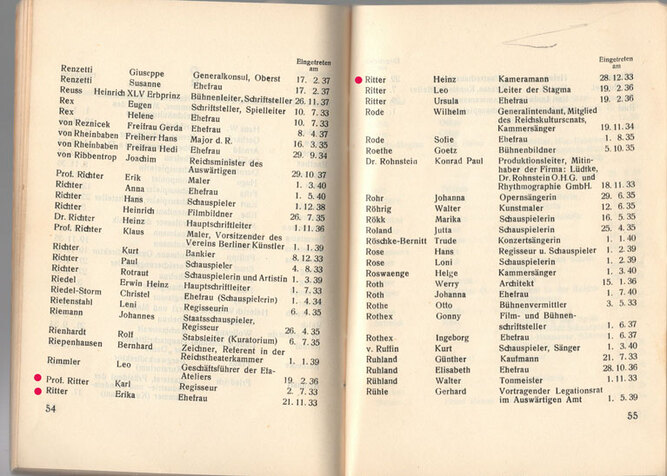
–––––––––
The Im Kampf gegen den Weltfeind cinema chain poster and the cinema owner's guide to the film (Werberatschlag) have now arrived safely Down Under. Also in the same package, the extraordinarily rare 'Das Programm von Heute' for the first Leni Riefenstahl Party Day film, the banned Der Sieg des Glaubens, with artist card. This order took 65 days to reach us and we were not actually sure that it had not been lost in the COVID-affected overseas postal service!
–––––––––––––––––––––––––––––––––––––––––––––
Karl Ritter's Pour le Mérite (1938) is naturally of special interest to us and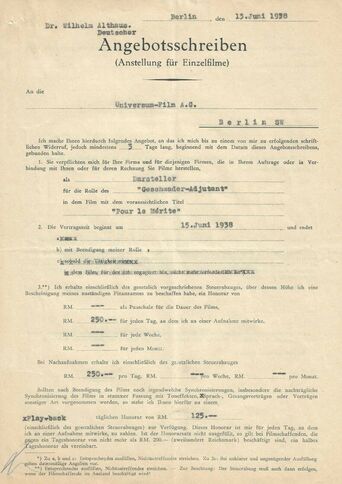 we have over the years won at auction scattered items from the estate of one of the character actors who appeared in the film as a WWI officer, Wilhelm Althaus. Items include his invitation to the film's premiere at the Ufa-Palast-am-Zoo on 28 December 1938, some lobby cards, an autographed postcard of him in the film, and also his personal copy of the actual Ufa film script. Today we have won his one sheet two-sided Ufa contract to appear in the film. Such contracts are rarely on the market, and being Pour le Mérite, we just had to have it. The seller's image of the front page is shown at right.
we have over the years won at auction scattered items from the estate of one of the character actors who appeared in the film as a WWI officer, Wilhelm Althaus. Items include his invitation to the film's premiere at the Ufa-Palast-am-Zoo on 28 December 1938, some lobby cards, an autographed postcard of him in the film, and also his personal copy of the actual Ufa film script. Today we have won his one sheet two-sided Ufa contract to appear in the film. Such contracts are rarely on the market, and being Pour le Mérite, we just had to have it. The seller's image of the front page is shown at right.
–––––––––––––––––––––––––––––––––––––––––––––––––––––––––
Last November we won at auction in Italy three Italian film posters for German Third Reich films: Die Geierwally, Salonwagon E417, and Zentrale Rio.
 Given COVID postal service disruption to Australia and also heritage export certification from the Italian government now required for such purchases, we have just received the posters safely Down Under.
Given COVID postal service disruption to Australia and also heritage export certification from the Italian government now required for such purchases, we have just received the posters safely Down Under.
We show here the Italian poster, 70 cm X 100 cm, for Hans Steinhoff's Die Geierwally. It and the other two posters have now been added to our Poster Gallery.
–––––––––––––––––––––––––––––––––––––––––––––––––––––––––
On the heels of acquring both the cinema owner's promotion guide to Ritter's Im Kampf gegen den Weltfeind, and a Berlin cinema chain poster for that film, a friendly collector alerted us to a cinema handbill on the film for sale on a militaria website. We snapped it up, too.
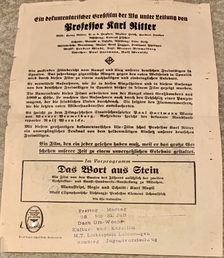

––––––––––––––––––––––––––––––––––––––––––––––––––––––––––
Although it is not an item associated with a German film, it is one which relates to our most recent book Legion Condor – Karl Ritter's lost 1939 feature film. We have won at auction an extremely rare original envelope and a two-page letter, fully intact, posted on 31 January 1939 by a Condor Legion airman in Spain to his wife or girlfriend back in Germany. The secrecy 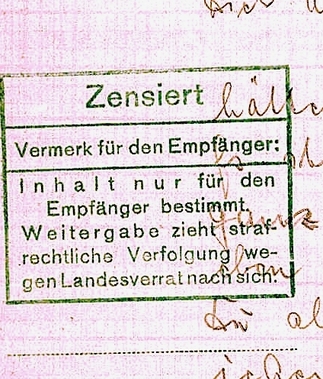 of the role of German airmen in the battle for a non–Communist Spain was maintained by the use of a cover name and address for all correspondence. This intriguing story is told in our book as a prelude to the making of the hard-hitting anti-Red feature film by Karl Ritter. Such empty Legion Condor envelopes come to the market perhaps once every five years or so, but none we have seen heretofore have also contained the airman's correspondence posted in such an envelope. The letter therefore also provides us with the censorship rubber–stamp, warning that the "contents are intended for the recipient only -- any reproduction will entail criminal prosecution for treason." The airman writing says in the letter that although they have " had some heavy fighting" he does ask her not to worry too much ("kein große Angst") about him.
of the role of German airmen in the battle for a non–Communist Spain was maintained by the use of a cover name and address for all correspondence. This intriguing story is told in our book as a prelude to the making of the hard-hitting anti-Red feature film by Karl Ritter. Such empty Legion Condor envelopes come to the market perhaps once every five years or so, but none we have seen heretofore have also contained the airman's correspondence posted in such an envelope. The letter therefore also provides us with the censorship rubber–stamp, warning that the "contents are intended for the recipient only -- any reproduction will entail criminal prosecution for treason." The airman writing says in the letter that although they have " had some heavy fighting" he does ask her not to worry too much ("kein große Angst") about him.
A nice complementary piece of authentic history added to our Collection.
–––––––––––––––––––––––––––––––––––––––––––––––––––––––––––
Film Ephemera out of actor Wilhelm Althaus' estate continues to interest us and we recently acquired his Ufa film contract to appear in the feature film Drei Unteroffiziere, for which we have the original poster in our Poster Gallery, as well as film stills and promotional material -- such as the 'Werberatschlag' or cinema owner's promotional guide to the film published by the film studio. The Ufa contract came with two stills of him in the film.
We also obtained a nice large portrait studio photo of him in his WWI officer's uniform for the Karl Ritter film Pour le Mérite and a Völkischer Beobachter full–page newspaper article on the film, published 16 days before the film's world premiere in Berlin at the top Ufa Palast am Zoo movie palace.
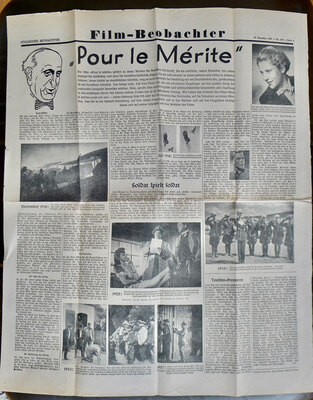
We have also just acquired the very rare Italian film promotional brochure for Karl Ritter's GPU film:
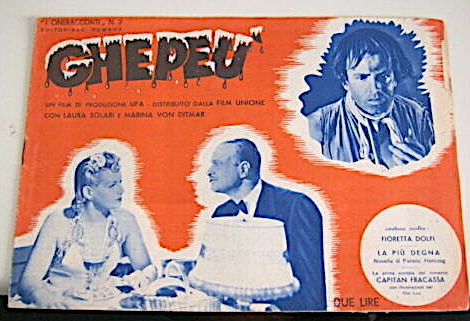
––––––––––––––––––––––––––––––––––––––––––––––––––––––
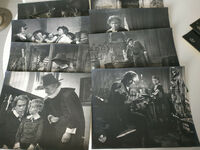 We have acquired from a seller in Ukraine seventeen double-weight lobby cards for the Hans Steinhoff biopic Rembrandt. The seller claims that his supply of original NS film stills were left behind by the Germans in WWII -- a very believable story. These bring our Rembrandt film stills to 25 lobby cards and one press photo.
We have acquired from a seller in Ukraine seventeen double-weight lobby cards for the Hans Steinhoff biopic Rembrandt. The seller claims that his supply of original NS film stills were left behind by the Germans in WWII -- a very believable story. These bring our Rembrandt film stills to 25 lobby cards and one press photo.
––––––––––––––––––––––––––––––––––––––––––––––––––––––––––––––––––
To complement our new Heinz Paul Tannenberg poster,we have acquired a large 54 cm X 40 cm advertising broadsheet on the film, which we have scanned at a readable resolution on the poster page.
----------------------------------------------------------------------------------
We've added two lobby cards for the Italian-Spanish co–production of Frente de Madrid / Carmen fra i Rossi (In der roten Hölle). They are excellent scenes from ths anti–Red Spanish Civil War film, issued by the Bassoli film studio in Italy but printed with the Spanish title of the film.
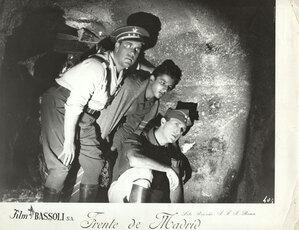
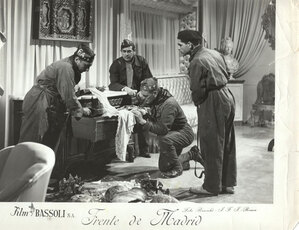
––––––––––––––––––––––––––––––––––––––––––––––––––––
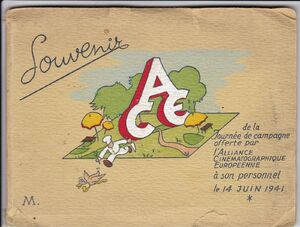
We have acquired a souvenir photo album from 1941 Occupied France, of 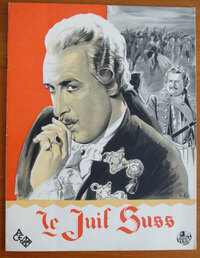 the Alliance Ciné. Européenne (ACE) organisation, which was the main distributor of German and Italian (and other foreign) films into France prior to and during WWII. For example, the Jud Süß press-book printed in Paris for the film's run as Le Juif Suss has both the Tobis and Ufa film studio logos and that of ACE printed on it –– see image at right.
the Alliance Ciné. Européenne (ACE) organisation, which was the main distributor of German and Italian (and other foreign) films into France prior to and during WWII. For example, the Jud Süß press-book printed in Paris for the film's run as Le Juif Suss has both the Tobis and Ufa film studio logos and that of ACE printed on it –– see image at right.
The album cover says: Souvenir of the Campaign Day offered by ACE to its staff on June 14, 1941.
The album comes with 15 photographs such as the one shown here:
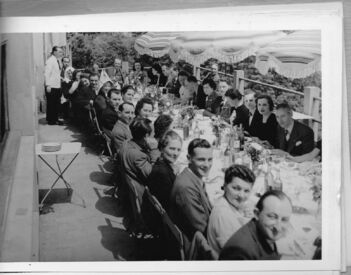
Photos of personnel are rarely found outside of ACE publications from the era, which invariably only show the ACE's key representative(s) in major French cities.
----–––––––––––––––––––––––––––––––––––––––––––––––––––––––––––––
We recently participated in an on-line poster auction in Italy and won over a dozen Italian posters of pre-1945 German films, including ones for the films Kongo-Express, Kautschuk, Die Geierwally, Die gelbe Flagge, Gold in New Frisco, and Bismarck. We have now added images of all of these posters to our Poster Gallery.
––––––––––––––––––––––––––––––––––––––––––––––––––––––––––––––––
Readers who return to this website regularly may recall that we announced in August 2020 of having purchased 30 rare personal snapshots of the 1944 filming of Veit Harlan's final epic for the Third Reich, Kolberg. We 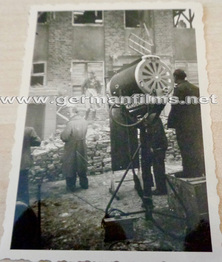 subsequently removed notice of this find, as the photos never arrived. We have recently been told by the seller, after months of a total vacuum in information, that the order was shipped from Hannover and then Returned to Sender no less than four times. We have now reimbursed the seller €50 to cover the postage charges he thus incurred; and we have had it confirmed by a third party that the photos have indeed been shipped. We show at right one of the photos depicting the film lighting equipment and some of the film crew on set.
subsequently removed notice of this find, as the photos never arrived. We have recently been told by the seller, after months of a total vacuum in information, that the order was shipped from Hannover and then Returned to Sender no less than four times. We have now reimbursed the seller €50 to cover the postage charges he thus incurred; and we have had it confirmed by a third party that the photos have indeed been shipped. We show at right one of the photos depicting the film lighting equipment and some of the film crew on set.
–––––––––––––––––––––––––––––––––––––––––––––––––––––––––
We have won at auction in Munich a most intriguing bound volume which we look forward to receiving in the weeks ahead. After the Red Army captured the Ufa Babelsberg studio facilities and grounds outside of Potsdam in April 1945, they removed a huge amount of material as war booty and shipped it back to Moscow. This included not only the film print library, but production files, hundreds of scripts, the photo archive, thousands of costumes, props, all but one of the 35mm cameras and other film equipment, even furniture from the Lehrschau training school. Much of it is still there, according to a graduate student we know who gained access a few years ago.
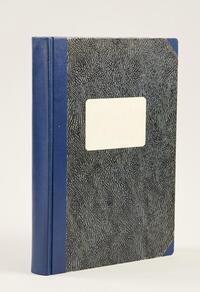 The bound volume at left contains about 150 pages of charts, spreadsheets, diagrams, and information about German film production since 1933 and specifically that of Ufa, including about 60 pages of film contracts, atelier plans, film schedules, and budgets from 1943-1945. It was compiled by a Fritz Thron for the "Russian Technical Office for Cinematography" † -- in other words it is a background report on the film studio which the Soviets had "acquired" and how it had operated up to 1945, focusing on economic information on the film productions. Intriguingly, there is at least one page on the Karl Ritter Production called Das Leben geht weiter (Life goes on...) which was only two-thirds completed before the Reds arrived; and remains the last propaganda feature film of the Third Reich and had had major input from Dr. Joseph Goebbels. Any original material on this lost film is highly rare. We reproduce below the page we know about on that film, provided by the seller. We are hopeful that more original documentation on this particular film is also to be found in the volume when it arrives.
The bound volume at left contains about 150 pages of charts, spreadsheets, diagrams, and information about German film production since 1933 and specifically that of Ufa, including about 60 pages of film contracts, atelier plans, film schedules, and budgets from 1943-1945. It was compiled by a Fritz Thron for the "Russian Technical Office for Cinematography" † -- in other words it is a background report on the film studio which the Soviets had "acquired" and how it had operated up to 1945, focusing on economic information on the film productions. Intriguingly, there is at least one page on the Karl Ritter Production called Das Leben geht weiter (Life goes on...) which was only two-thirds completed before the Reds arrived; and remains the last propaganda feature film of the Third Reich and had had major input from Dr. Joseph Goebbels. Any original material on this lost film is highly rare. We reproduce below the page we know about on that film, provided by the seller. We are hopeful that more original documentation on this particular film is also to be found in the volume when it arrives.
† " After the Potsdam Conference (1945), during which the Ufa site in Babelsberg was occupied by Allied troops, the Technical Bureau for Cinematography (TBK) at the State Committee for Cinematography at the Council of People's Commissars of the USSR moved to the (destroyed) site and began with scientific and technical research by German experts. The skimming off of German film-technical knowledge is used as reparation for the Soviet side, the bringing together of German scientists and technicians as an advance payment for the future " [war reparations.]
note: this quote on the Soviet Technical Bureau for Cinematography is found on the DEFA-Stiftung website.
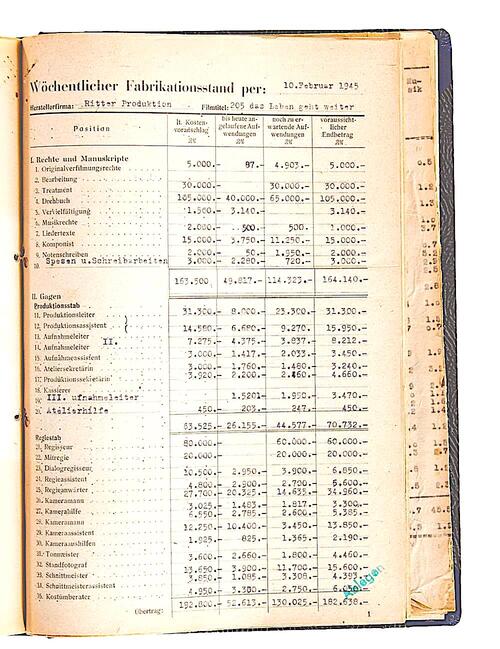
The film reels of Das Leben geht weiter were hidden in April 1945 in the 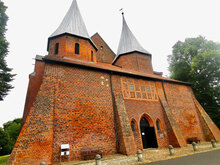 crypt of the church in Bardowick just before the arrival of British troops. The film was a Nitro print, meaning that it was highly flammable (not "safety film"). Children from the town discovered the reels and lit them up, where they sparked and erupted into flames, which entertained the children as if they were igniting fire-crackers. This story on "the last propaganda film of the Third Reich" is told in the documentary film of 2003. At right, we show a photograph of the church in Bardowick, taken by a friend (MR), with thanks.
crypt of the church in Bardowick just before the arrival of British troops. The film was a Nitro print, meaning that it was highly flammable (not "safety film"). Children from the town discovered the reels and lit them up, where they sparked and erupted into flames, which entertained the children as if they were igniting fire-crackers. This story on "the last propaganda film of the Third Reich" is told in the documentary film of 2003. At right, we show a photograph of the church in Bardowick, taken by a friend (MR), with thanks.
–––––––––––––––––––––––––––––––

After sporadic searches over the past seven years --since our 2nd ed. KARL RITTER biography was published -- we have finally acquired the 1. September 1945 Allied Forces newspaper intended for the German civilian population in Bavaria. This issue is the one which we quote in the RITTER book on page 62, as follows:
“Rosenheim – Among the prisoners in Rosenheim prison for some
time is also the former film producer and director Karl Ritter. He
belongs to those men who were responsible for deciding the mental
preparation of the masses for war through film. From Hitlerjunge
Quex (director: Hans Steinhoff) through to GPU, the films Ritter produced
or staged all solely had glorification of militarism and of National
Socialism.”
The news of Ritter's arrest prompted an article a week later, in the 8. September 1945 "Deutsche Volkszeitung" published by the Communist Party of Germany in Berlin demanding that Ritter be tried for War Crimes as a film director of such "hateful" films as Hitlerjunge Quex, Kadetten and GPU. We also quoted this paper in our RITTER biography and also have after a long search acquired the original copy of this paper, too.
–––––––––––––––––
 We won at auction the Danish original poster for Veit Harlan's Der Herrscher, starring Emil Jannings in the title role, with Marianne Hoppe Hilde Körber, and Hannes Stelzer amongst others in a fine cast. This is the fourth poster for this film we have acquired over many years, along with three Italian Fotobusta -- all to be seen in our Poster Gallery. This new poster will be re-photographed and added to the Poster Gallery upon arrival from North America.
We won at auction the Danish original poster for Veit Harlan's Der Herrscher, starring Emil Jannings in the title role, with Marianne Hoppe Hilde Körber, and Hannes Stelzer amongst others in a fine cast. This is the fourth poster for this film we have acquired over many years, along with three Italian Fotobusta -- all to be seen in our Poster Gallery. This new poster will be re-photographed and added to the Poster Gallery upon arrival from North America.
––––––––––––––––––––––––––––––––
Arnold Fanck was the acclaimed pioneer of the German "Mountain Film" and the man who gave Leni Riefenstahl her first–ever contract in motion picture history. But he also made other feature films than the famous silent films such as S.O.S. Iceberg and The White Hell of Pitz Palu. Two other such films from the sound era for which you can find original German posters in our Collection are his Ein Robinson and Die Töchter des Samurai. The latter was the first–ever co–production between Germany and Imperial Japan.
 We have purchased an interesting group of 13 original silver gelatine ca. 10 x 12 inch photographs taken "behind–the–scenes" during the filming of his S.O.S. Eisberg, starring Gustav Diessl, Leni Riefenstahl, Sepp Rist, and famed aviator Ernst Udet. The photos were taken on location in 1932 in Greenland. One is shown here at right.
We have purchased an interesting group of 13 original silver gelatine ca. 10 x 12 inch photographs taken "behind–the–scenes" during the filming of his S.O.S. Eisberg, starring Gustav Diessl, Leni Riefenstahl, Sepp Rist, and famed aviator Ernst Udet. The photos were taken on location in 1932 in Greenland. One is shown here at right.
Also in the purchase were thirty–three small private snapshots, taken by Fanck during the film-shoot of Ein Robinson off of the Chilean coast, on islands used to tell this modern-day " Robinson Crusoe " of a German Kriegsmarine sailor who survived the WWI British sinking of his ship the Dresden off the coast of Chile, returned to post-war Germany in the throes of inflation, Communist uprising, despair and defeat and who decides to leave his homeland in utter disgust and to return to Chile to live a solitary life on an island far away from civilisation. Years later, the new Dresden cruiser built by the Third Reich Kriegsmarine sails to South America, and the sailor eventually hears of the ship's arrival and chases it along the coast in a small craft until he is saved by the ship's sailors. They tell him of the New Germany and hail him as a hero.
Update: This is our Arnold Fanck week! We just won the very rare cinema owner's guide (Werberatschlag) to the Fanck film Die Tochter des Samurai, which was the first ever co-production between Japan and Germany -- in this case, between Imperial Japan and the Third Reich. We own one of the rarest posters found in our Collection of this film, and this guide has the image of that poster, as well as a second alternate poster. Heretofore we had never found an image of our poster in any publication either pre-WWII or after. We show images of this guide as listed when offered for sale, but they are not optimal and the poster page is not shown in its entirety. The poster we own is the one on the left on that page below.
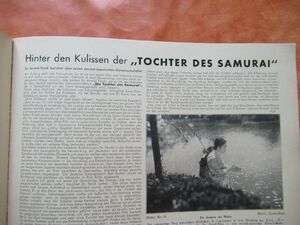
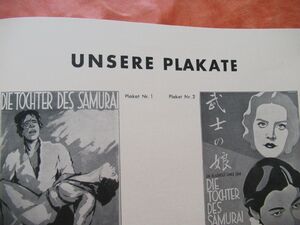
------------------------------------------------------------------
In 1941 the Third Reich charity the Winter Assistance Relief auctioned off 25 copies of a sheet on which the film director Gustav Ucicky and the nine principal actors of the propaganda film Heimkehr signed their autographs. The sheets were issued in the town of Prasnitz on March 2,1941 where the exterior scenes for the film were shot. We have only seen two of the surviving sheets come up for sale over the years. The second one we saw this year, and we have just won it at auction. An image of the sheet is shown below.
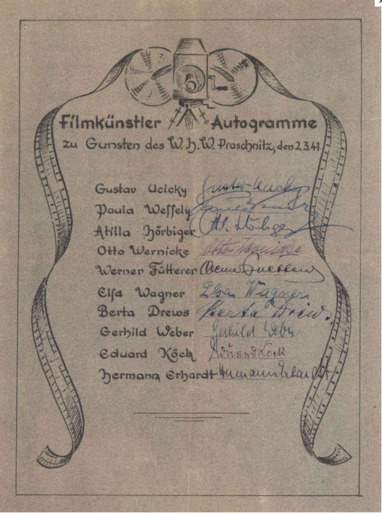
-------------------------------
The behind-the-scenes snapshots of the filming of Kolberg, taken between 5 and 16 June 1944 by an extra who appeared in the film, Heinz Rieckehr, have finally arrived. They were ordered in August 2020, were then sent 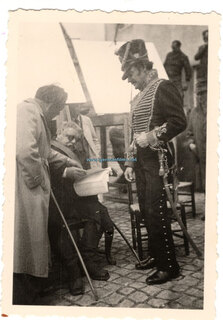 and 'Returned to Sender' three times, and it took months to find out what had happened to them. After reimbursing the seller €50 for having paid for postage to Australia four times; they were then sent to a colleague in Germany, for safe-keeping. A package from that colleague was then sent in early September this year and arrived here six weeks later.
and 'Returned to Sender' three times, and it took months to find out what had happened to them. After reimbursing the seller €50 for having paid for postage to Australia four times; they were then sent to a colleague in Germany, for safe-keeping. A package from that colleague was then sent in early September this year and arrived here six weeks later.
There are 23 different small album snapshots as well as three original Ufa press photos from the film in the photographs we purchased. To the right is one of the snapshots scanned at 1200 dpi to enlarge it, showing Veit Harlan (left) conferring over the film script, with the great actor Heinrich George (sitting, wearing sunglasses) with actor Gustav Diesel (right), looking on.
–––––––––––––––––––––––––––––––––––––––––––––––––
–––––––––––––––––––––––––––––––––––––
It is not often that we are surprised by any film material which surfaces about Karl Ritter and his films. After all, three books on him and his films have been published by German Films Dot Net since 2012. But we have to admit that this promotional brochure on Ritter's Patrioten, part of his immensely successful WWI Trilogy of films, really did so. The wording on the front page translates as "Broken Wings." This in and of itself is not necessarily unusual, since the plot surrounds a German pilot whose plane crashes behind French lines in WWI and his evasion of being captured. But inside the brochure, the text clearly announces "the film Broken Wings" (" Der Film Gebrochene Flügel ") twice. This is the film released as Patrioten in 1937.
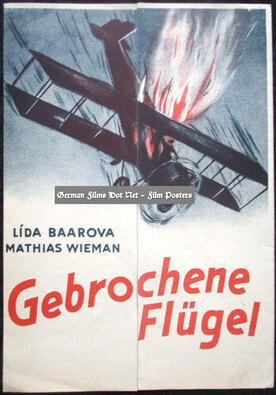
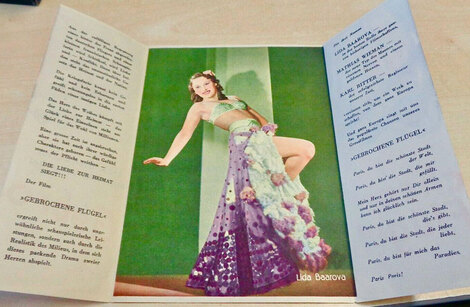
Interesting is the fact that this film was referred to as Patrioten –and never once as Gebrochene Flügel -- in the Ufa film studio Board minutes in 1937. The very first mention of the film at all was in the Ufa Board minutes of 27 April 1937, when the film was first authorised to be produced. Colleagues in Prague have confirmed that the Kino Avion printed on the brochure was located in Prague at Wenceslas Square 41. The cinema was subsequently renamed. "Letka" and also "Čas" ("Time" in English). Today it is the Bookstore Luxor Palace. Thus, the film title was changed when the film was shown in Baarova's home country prior to WWII. Mystery solved.
––––––––––––––––––––––––––––––––––––––––––––––––––––––
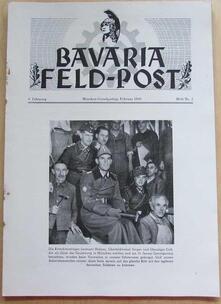
We have acquired twenty-three issues of the the Bavaria Feld–Post 8 page magazine of scattered issues from 1942 to 1944. This was the magazine published by the Bavaria Filmkunst studios to inform all Bavaria film studio members of the Wehrmacht and other military branches serving on the war Fronts of happenings back at the film studio during WWII.
Such issues are not often found outside of film archives.We do own a bound volume of the the issues from November 1939 to October 1941, so these later years ones are especially welcome. With these issues we have in our publications library all but one issue from the first issue in November 1939 through to October 1941 inclusive.
–––––––––––––––––––––––––----------------------
As the year draws to a close, we won at auction the 1941/42 TOBIS Filmkunst annual preview catalogue for films being released in Belgium-Included in that line–up were Ich klage an, Bismarck, Dorf im roten Sturm (Friesennot re–release), Carl Peters, Friedrich Schiller, amongst others. Shown here the page on Dorf im roten Sturm.
–––––––––––––––––––––––––––––––––––––--------
